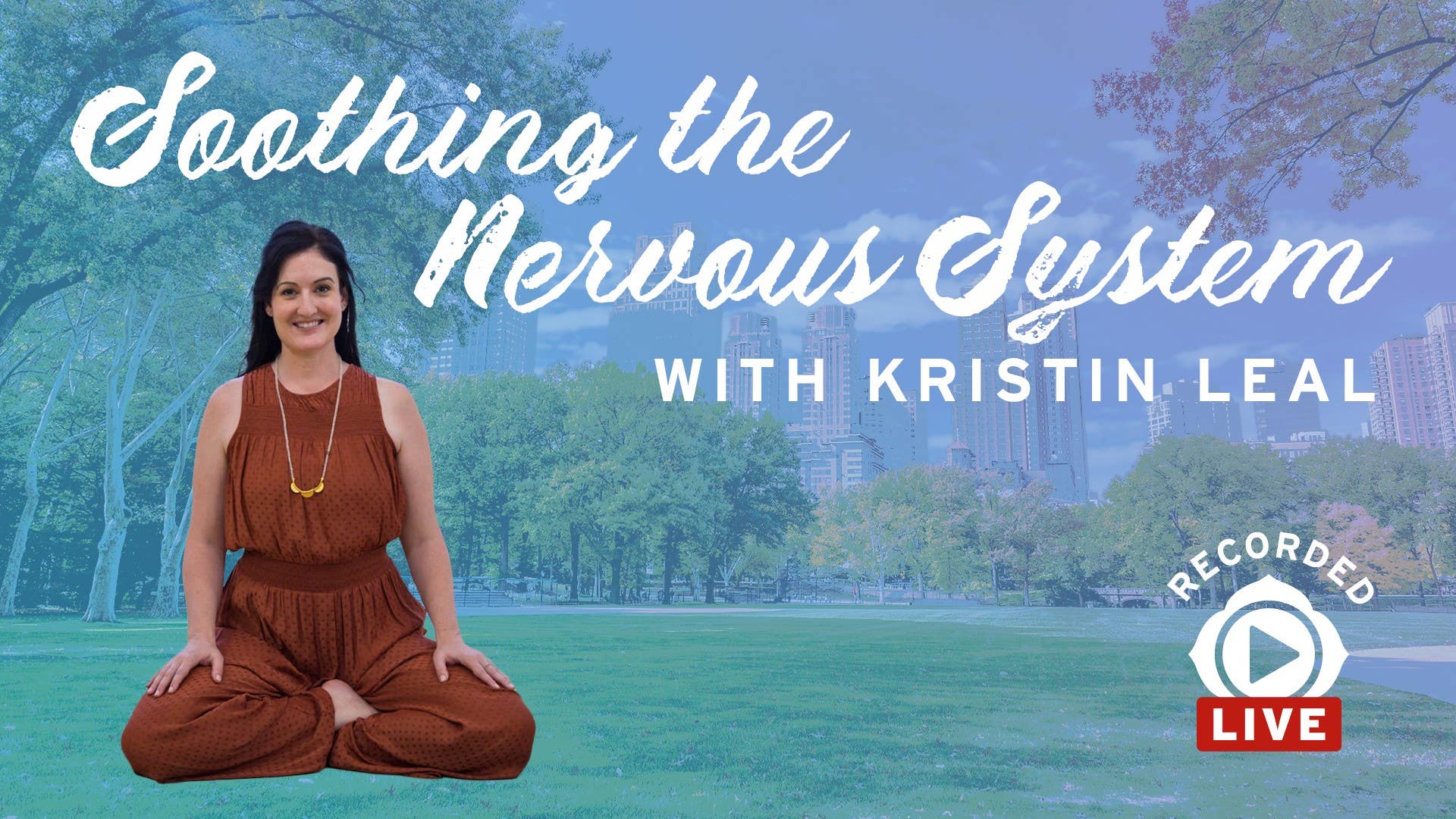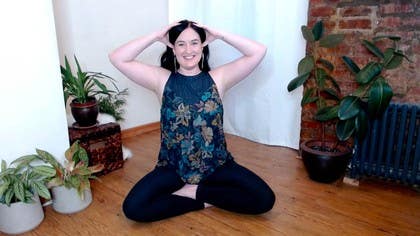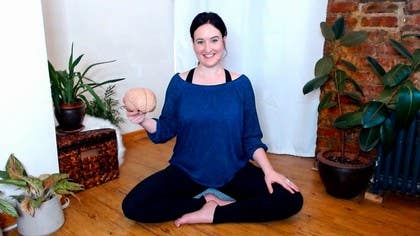Description
We begin seated rooting into the ground as Kristin leads us in Chandra Bhedana breathing, bringing about a more calm, meditative state. After a brief talk about the effect of the breath on Parasympathetic Nervous System activation, Kristin guides us in a Moon Nectar Yoga Nidra practice where we are invited to sense the nurturing quality of moonlight while internally repeating the mantra "Soma". You will feel nourished and restful.
You can follow along with the Grounding Mantras at the end of each class by accessing the PDF attached below.
About This Video
Transcript
Read Full Transcript
Namaste. We're going to start in a seated position to begin. So if you want to come to sit on the edge of some props, a pillow, or even on the edge of your chair if you're using one. If you're in a chair, you can place your feet on the floor if possible, just so you feel a little bit more rooted. Organize yourself so that you can be steady and still for what could be about 5-10 minutes. We'll see how it goes. You can start by placing your palms face down onto your knees or thighs. You root down through the parts of your body that you feel in connection to the earth below. You can feel the tall, curvy ascension of your spine upwards and almost regal balancing of your crown over your tail. As you feel really ready to do so, you can close your eyes and just start to make the transition from whatever you were doing before to our time together here. You can start by just tethering yourself to the sensations that you feel in your body, the rise and fall of sensation. So whether that's an area that feels particularly spacious, an area that feels a bit grumpy. We all have grumpy areas. And just notice what you're bringing with you in your mind into this moment. Maybe again it's an area that feels very spacious or grumpy. Just simply labeling this as your starting point, this moment, this very transient moment of now. And turn your mind towards the sensation of your breath, the presence of breath in your body in its natural state. No need to fuss with it. As you become aware of the really subtle movement of the breath in the body, you might just notice it in the abdomen or belly. And if it's helpful for like a little kinesthetic awareness, you can bring your hands onto your own belly and just let the awareness rise and fall on the belly as you breathe. Again not really needing to change it or fix it or make it somehow more yoga like. Just see if you can sense any movement of your belly as you breathe naturally. And then allow yourself to become aware of any sensation of the movement of breath in the chest. Again if it's helpful for you, you can bring your hands in some way onto the chest or ribs or breastbone. Not needing to change the breath but just awareness of any sensation of the passage of the easy breath through the chest. As you get a bit quieter, the breath may be even a little bit more shallow. See if it's possible to draw the awareness to any sensation that you feel at the tip of the nose or through the walls of the nostrils. And if it's helpful, you can take your hand a couple of inches in front or underneath your nose and just feel or sense the breath finger to finger with away from the nostrils. You might even start to sense that one nostril is a bit more dominant than the other like it's doing more of the work. Quite normal, quite natural. Our body on its own will begin to switch dominance in the nostrils every 88 or so minutes. So you might find that one is particularly doing more of the breath than the other side. Take your right hand and we'll create what's called Vishnu Mudra. So right index finger and middle finger right at the space in between your eyebrows, maybe slightly above. Right thumb and fourth finger right above the creases of your nose, kind of slightly above where you'd get a nose piercing right underneath the bony cartilage. Breathe in and out through both nostrils.
As you're ready, close your right side, your right nostril with your thumb, just giving it a little pressure with your right thumb. And inhale a long slow breath in through the left nostril. Inhale so deeply that you sit up a little bit taller, your collarbones lift, your spine lengthened, your ribs open. At the top of that inhale close both sides of the nose gently. Pause. And then exhale through the right nostril, exhaling long slow deep breath through the right nostril. Then we're going to do that again, close the right side, exhale through the left nostril. Slow, deep, kind of luxurious breath, letting it unfold into the body. And sit up a little taller, lift your heart a bit higher. Close both sides of the nose gently. And then as you need to, exhale through the right nostril. Long, slow, full, deep breath out. We're going to do that a few times, inhaling through the left, taking your time. At the top of the breath, just hold and pause, closing both sides of the nose gently. And without strain or gulping, just exhale when needed through the right side. A few more times on your own, whatever pace is reasonable. There's no need to force in through the left and slowly out through the right. Please continue a few rounds. Slowly over time, this is making the left nostril more dominant. Practice called Chandra Bhedana. Chandra meaning moon, Bhedana piercing, bringing about a more lunar, calm, feminine, yin, meditative, restful state. A couple more times, in through the left and out through the right. Now finish your next exhale, take your time to get there. As you finish the exhale, keep your eyes closed and just lower the right hand down to your thigh, knee, or lap. And just let yourself pause and kind of sit in whatever experience that brought. You can notice if there's shifts in your body sensation, shifts in your mind or emotional body. Maybe in the presence or in your relationship to the breath, was there a shift? Let's draw the tip of your tongue to the roof of your mouth. Just give it a little press with your tongue. Bow your chin towards your chest. Take a moment to flutter your eyes open, just maybe a really hazy gaze at one point on the floor. There's really no rush here. Once you're ready, you can allow the rest of your room and each other to come back into your focus. It's amazing what a couple of minutes of breath can do, both to your physical body, but your own experience of your mental and emotional forms, really the experience of your physiology can shift just with a couple moments of awareness of your breath. Feel free right now to stretch your legs out. I know that was a little bit longer of a sit, so you can shake your legs out, get some blood flow back into them. Over the last few classes, we've been really looking at different parts of the nervous system and how we might address the nervous system. Last class, we looked at really the autonomic branch of our nervous system. This is the stuff that's happening with the law and to itself. It's not something that we consciously have to interplay with or interact with, like your heart is beating, you're digesting your burrito. All these things are happening without, luckily, your conscious interplay. This is also the very hackable part of your system. The autonomic nervous system has those two subdivisions that we can look at, the sympathetic and the parasympathetic. The sympathetic, sometimes termed fight or flight or what I call the engagement system, and parasympathetic, the rest and digest, the restful relaxation system. We need, of course, access and maybe even through the techniques and technologies of yoga, mastery of both. Last practice, we looked quite a bit at sympathetic. I'd like to spend our day today talking about parasympathetic, this rest and digest, this relaxation, this easefulness. It's really the aspect of our nervous system where all the housekeeping activities get taken care of. This is the stuff in the body that takes longer to deal with. Digestion is a long-term process. This is not something that happens quickly. Reproduction, lining of the uterus and production of the sperm. This is not instantaneous. This is a long-term process, building a baby, long-term process. Immune function is a long-term process, housekeeping activity, searching out for bacteria and viral invaders and doing their job. This is long-term activity. Memory consolidation, shuttling things from your short-term to long-term memory. This is a longer activity. These are the things that are fostered, cellular growth and repair, fostered when you're in parasympathetic activation. If you remember, every 88 or so minutes, we are meant to, in a perfect world, kind of pendulum back and forth gently between sympathetic activation and parasympathetic activation, engagement and rest. To be a balanced individual, to have a little bit, 88 minutes in one little transition time, then 88 minutes in the other. That's in a perfect world. I don't know about you, but it ain't a perfect world. Sometimes we get stuck. Often, of course, we get stuck in sympathetic, in this engaged model. When we get stuck in the engaged fight or flight portion of our system, it's like whispering to those long-term activities. It's like whispering to your digestive system or your reproductive system or your immune function. Hey, you're not really needed. Take some time off. We've got bigger fish to fry. Don't worry about it. Those energy to those systems becomes depleted because it's really focusing on how to engage, how to do your stuff, how to flee from the tiger, how to really engage. It starts to move energy away from those long-term housekeeping activities. It's extremely beneficial and useful to utilize these practices of yoga and very specific practices that we'll go into to help give you a big parasympathetic moment, to give you a big bang for your buck, parasympathetic activation, which will then set the pendulum back into its more healthful swing and balance. Sometimes if we can get a big bang for your buck, parasympathetic moment, we move ourselves back into harmony, into balance.
Some of the things that we can do in utilizing these yoga technologies, these alchemical practices, is as simple as, I'll say it's simple, it's often not easy, but the simple practice of deepening your breath. That old advice from your mom of take a deep breath, take a deep breath, sometimes that's enough to trigger a parasympathetic moment, a parasympathetic activation, especially if we emphasize the exhale phase of the breath. Every time you inhale, there's a nerve that goes to the heart called the cardiac sympathetic nerve, which will speed the heart beat up. Every time you exhale, there's another nerve that goes to the heart called the vagus nerve, which will slow the rhythm of the heart down. If we extend the exhale longer than the inhale, we're extending that activation of the vagus nerve, which can be enough potentially to trigger a parasympathetic moment activation. So deepening the breath, particularly with the emphasis on the exhale can be useful. And then also surprisingly enough, that left nostril breath that we did, Chandra Badana. Every 88 or so minutes, one nostril is more dominant than the other. Through the magic of your autonomic nervous system, one nostril will be dominant. When your left nostril is predominant, your parasympathetic is more dominant. When your right nostril is more dominant, sympathetic is more dominant. So this is happening without your conscious kind of interruption or interplay with it. But yogis can hack into that system. And to bring more dominance into the left nostril, doing that moon piercing breath, Chandra Badana in through the left out through the right, after a few minutes, it'll make the left nostril more dominant, which will make the parasympathetic more dominant. When parasympathetic is dominant in yoga terminology and yoga language, we say that Ida, Ida Nadi is predominant. And that is our feminine, lunar, meditative, cooling yin aspect of our duality. So we can activate those qualities in us if need be, we can hack into the system, if need be to bring about a more restful state, meditative state. And that leads us very nicely into the practice I'd like to do today, which sometimes I call the moon nectar nidra yoga nidra practice. So all you'll need is a place to lie down, preferably on the floor, or some folded blankets. You could do this in bed, but you have a very strong, some scarra, very strong kind of pattern that when you get into bed, and you get all cozy, and you put your blankets on and everything, you just go unconscious, which is fine. If you want to take a snooze, that's fine too. But if you'd like to do the nidra might be a little bit easier if you find some space on the floor. Since we will be there for what could be about 30 minutes or so, you want to take a bolster pillow rolled up blankets or towels underneath your knees, that'll keep your low back a little bit more comfortable. And if you're on a harder floor, harder surface, maybe a flat folded blanket, not too high, but a flat folded blanket underneath your head, your head tends to get a little annoyed if it's on the floor for too long. If the temperature in your room is just a little bit cool, your body does tend to cool down as you relax, parasympathetic activation. You might choose a blanket or extra clothing right now just to kind of hedge your bets. If you want to take something over your eyes to block out some light, very soft pressure on the eyeballs or the muscles surrounding them, very light pressure can also help to trigger the vagus nerve parasympathetic activating. Set yourself up well. Take these last few moments to make any adjustments that you need to in your body. It's worth your time. Just say you're not annoyed by it later. And as you get all cuddled up there, you can let your heels fall a little wider than your hips.
Maybe turn your legs in and out a few times, just feel like they really can let go. You don't need to muscurally support or hold them. You can move the arms a little bit away from the sides of your body, turning the palms to face up. You can let the fingers just naturally relax inwards. Any little bobblehead action with your head and neck to find the perfect neutral-feeling position.
And if you haven't gotten there already, I'll close your eyes and smoothing out the forehead. A little strip of real estate in between the eyebrows widens. And jaw relaxes, your lips might even part. Tongue falling into the floor of the mouth behind the lower set of teeth. And just turn your attention towards any sounds that you hear around you.
Let's see if you can just identify maybe the sound furthest away from you. Maybe it's in your room, maybe it's my voice. Could be the kids playing outside my apartment. Just let your mind move from sound to sound to sound. Oftentimes, the mind wants to judge the sounds, either figuring them out or seeing how you can quiet them.
Just let the mind move sound to sound to sound without the need to push them away or grab them closer. Okay, now turn the awareness towards any sounds from inside your body, the gurgling of your stomach, the sound of the breath, sounds that are a bit closer to you. Now become aware of the parts of the body that are in connection to the floor and the earth and the padding below you. So awareness of the particular unique place of your heels and the earth. Feeling the parts of the calf, thighs, or seat, and their connection to the earth below you.
The particular portions of the spine that you feel resting on the earth. It's part of the shoulder blade, elbows, maybe back of the hand, and their connection down. And the unique positioning of your head in contact with the earth below. Feeling all these parts of the body, almost like they're little drains that you can pour out any efforting, holding, engagement, any tension, fatigue. It just pours down through those little drains, absorbed and transmuted by the earth herself.
Bring the awareness to any breath that you feel in your body. No need to shape the breath, just noticing the presence of breath in your body. And just silently begin to count back from 10, counting back each time you exhale. Next exhale, just feeling 10. Next exhale, 9.
Next exhale, 8. Each time feeling like you can let go a little bit more, becoming a bit heavier, all the way back to 1. And if you get lost, just start again at 10. Or if you finish early, just start again at 10. Next exhale, 10. And release the counting, no matter what number you've gotten to, just let it go.
Now feel the essence of moonlight. The glow, the luminous light of the moon. Just feel or sense, conjure the essence of moonlight. Nurturing, nourishing, rejuvenating. The essence of moonlight.
I'm going to name different parts of the body. And as I do, you can feel as if a drop of that moonlight, the nectar of the moon is placed in those areas. And as the nectar of the moon is dropped in the areas that I name, you can silently repeat or feel the mantra soma, soma, as if it's placed with the nectar of the moon at the parts of the body that I name. Bring your awareness to the space in between the eyebrows. Drop of moonlight, soma.
The pit of your throat, nectar of the moon, soma, the right shoulder, the right elbow, the right wrist, tip of the right thumb, soma, tip of the second finger, drop of moonlight, tip of the third finger, tip of the fourth finger, tip of the fifth finger, soma, right wrist, wrist, right elbow, right shoulder, center of the throat, left shoulder, drop of moonlight, left elbow, left wrist, tip of the left thumb, tip of the second finger, tip of the third finger, tip of the fourth finger, soma, tip of the fifth finger, left wrist, left elbow, drop of moonlight, left shoulder, pit of the throat, heart center, soma, right chest or breast, heart center, left chest or breast, heart center, navel, pubic bone, drop of moonlight, right hip, soma, right knee, right ankle, tip of the right big toe, second toe, third toe, fourth toe, fifth toe, right ankle, soma, right knee, right hip, pubic bone, left hip, drop of moonlight, left knee, left ankle, tip of the left big toe, drop of moonlight, tip of the second toe, third toe, soma, soma, fourth toe, fifth toe, fifth toe, left ankle, left knee, left hip, hip, pubic bone, navel, drop of moonlight, right heart center, pit of the throat, soma, space between the eyebrows, nectar of the moon, space between the eyebrows, feel the essence, the luminous glow of the moon, the space between the eyebrows begins to grow, sensing a full moon, and the whole face glows like the light of the full moon. See or visualize or feel a full moon at the face. See or feel the full moon at the throat, nurturing, nourishing, soft glow of the full moon at the throat. Feel the full moon in the cave of the heart, the essence and glow, luminous light of the full moon, illuminating the cave of your own heart. See or visualize the full moon in the cave of your own heart.
See or visualize the full moon in the cave of your own heart. See or visualize the full moon in the cave of your own heart. Now bring your awareness back into your body without opening the eyes. Just see your body resting here in the room that's around you, perfectly resting, and begin to deepen the breath, taking your time. Feel as if the breath can grow expansive and then it can animate your fingers and your toes, very gently waking the body. Please take your time.
You can turn your head a little side to side, it might feel nice to reach your arms overhead and give yourself a moment to stretch. Bending your knees, placing your feet on the floor, patting, and just roll over to one side, whatever side is easier for you right in the fetal position. You can make a little pillow with your arm for your head and just take a few moments here to reflect on whatever your experience was there. One of the beautiful things about parasympathetic and all these tools and tricks is the attempt alone at these techniques can be enough to trigger a parasympathetic response, even if you don't feel like you reached some yogic heights or saw the Buddha. The attempt alone can be enough to reset your nervous system.
And keeping your eyes closed or hazy, just use your hands to press yourself up lazily up to a seated position. Just to help us ground, take your hands together and rub your palms together, creating a little bit of heat. And then as you're ready, place your palms over your eyes, your closed eyes, and just feel a sense of heat wash back down through the system. It's sometimes helpful to reground intentionally after these practices, so I'll sing some of the grounding mantras and you can just listen and feel. So with the hands over the eyes.
Slide the hands down the sides of your face and jaw into the back of your neck. Taking one hand over the other hand over the throat lightly. Slide the hands down over the heart center. And sliding your hands down the front of your body to your navel center. Give a little press in with your hands so you feel a little bit of a pressure inwards, just to help reground, reroute.
Hands down over the lower belly. Take the hands to the crease line between your hip and thigh. Just give a little press down. Thumbs can face forward, the eight fingers facing back. As you press down, just draw your spine up a bit taller. Draw your elbows back. You can lift your heart in your chest and bring your chin down a little bit, just rerouting down into your hips and legs, grounding down.
And you can rub your from hips to knees. You can untangle your legs and just turn your hands over your knees a couple times, circling around your joints, down through the calves, kind of squishing down. Even down into your ankles, your feet. And even squishing into each toe. And then we'll bring the palms together in front of the heart.
Bowing your head. And just bowing down to your true teacher, your inner teacher, an inner seed of wisdom. In Sanskrit, that's Ombalo Shri Sat Gurbhagavan Ki. Jai Namaste.
Soothing the Nervous System
Comments
You need to be a subscriber to post a comment.
Please Log In or Create an Account to start your free trial.











